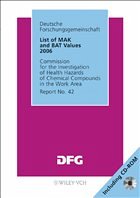This basis for judging the toxic potential of chemicals frequently encountered at workplaces classifies about 1000 compounds, with carcinogens, embryotoxicants, sensitizing substances or germ cell mutagens all treated separately. MAK and BAT values listed in full on CD-ROM.
MAK- und BAT-Werte sind ein Maß für das toxische Potenzial chemischer Substanzen und dienen der Gewährleistung des Gesundheitsschutzes am Arbeitsplatz. Dieser Band enthält die aus wissenschaftlicher Sicht empfohlenen Grenzwerte für die Konzentration von rund 900 Elementen und Verbindungen. Karzinogene, mutagene, embryotoxische und in der Schwangerschaft riskante Stoffe werden separat behandelt. Die Grenzwerte werden jährlich von einer Expertenkommission überarbeitet.
Special feature: the complete list of MAK- and BAT values on a CD-ROM included in the book! The CD-ROM allows easy searches e. g. for substance names or CAS numbers.
MAK values (Maximum Concentrations at the Workplace) and BAT values (Biological Tolerance Values) promote the protection of health at the workplace. They are an efficient indicator for the toxic potential of chemical compounds. This book contains a list of scientifically recommended threshold limit values for about 900 chemical compounds. Carcinogens, germ cell mutagens, embryotoxicants, sensitizing substances and those potentially bearing a risk to pregnancy are treated separately. The evaluations are revised annually by a commission of experts.
Of particular value are the lists of substances which were reviewed in 2005/2006 and substances being examined for the establishment of MAK and BAT values in coming years.
Table of contents:
SIGNIFICANCE, USE AND DERIVATION OF MAK VALUES
LIST OF SUBSTANCES
CARCINOGENIC SUBSTANCES
SENSITIZING SUBSTANCES
AEROSOLS
LIMITATION OF EXPOSURE PEAKS
PERCUTANEOUS ABSORPTION
MAK VALUES AND PREGNANCY
GERM CELL MUTAGENS
SUBSTANCES REQUIRING SPECIAL CONSIDERATION
SIGNIFICANCE AND USE OF BAT VALUES
LIST OF SUBSTANCES
CARCINOGENIC SUBSTANCES
BLW
CAS Number Index
CAS numbers of the substances listed in Sections II to XIV and on the yellow pages
Members of the Commission and Permanent Guest Contributors
Constitution and procedures of the Commission for the Investigation of Health Hazards of Chemical Compounds in the Work Area
Substances in the lists of MAK and BAT values reviewed in 2005/2006
Substances being examined for the establishment of MAK and BAT values
Procedure of the Commission for the Investigation of Health Hazards of Chemical Compounds in the Work Area for making changes in or additions to the List of MAK and BAT Values
MAK- und BAT-Werte sind ein Maß für das toxische Potenzial chemischer Substanzen und dienen der Gewährleistung des Gesundheitsschutzes am Arbeitsplatz. Dieser Band enthält die aus wissenschaftlicher Sicht empfohlenen Grenzwerte für die Konzentration von rund 900 Elementen und Verbindungen. Karzinogene, mutagene, embryotoxische und in der Schwangerschaft riskante Stoffe werden separat behandelt. Die Grenzwerte werden jährlich von einer Expertenkommission überarbeitet.
Special feature: the complete list of MAK- and BAT values on a CD-ROM included in the book! The CD-ROM allows easy searches e. g. for substance names or CAS numbers.
MAK values (Maximum Concentrations at the Workplace) and BAT values (Biological Tolerance Values) promote the protection of health at the workplace. They are an efficient indicator for the toxic potential of chemical compounds. This book contains a list of scientifically recommended threshold limit values for about 900 chemical compounds. Carcinogens, germ cell mutagens, embryotoxicants, sensitizing substances and those potentially bearing a risk to pregnancy are treated separately. The evaluations are revised annually by a commission of experts.
Of particular value are the lists of substances which were reviewed in 2005/2006 and substances being examined for the establishment of MAK and BAT values in coming years.
Table of contents:
SIGNIFICANCE, USE AND DERIVATION OF MAK VALUES
LIST OF SUBSTANCES
CARCINOGENIC SUBSTANCES
SENSITIZING SUBSTANCES
AEROSOLS
LIMITATION OF EXPOSURE PEAKS
PERCUTANEOUS ABSORPTION
MAK VALUES AND PREGNANCY
GERM CELL MUTAGENS
SUBSTANCES REQUIRING SPECIAL CONSIDERATION
SIGNIFICANCE AND USE OF BAT VALUES
LIST OF SUBSTANCES
CARCINOGENIC SUBSTANCES
BLW
CAS Number Index
CAS numbers of the substances listed in Sections II to XIV and on the yellow pages
Members of the Commission and Permanent Guest Contributors
Constitution and procedures of the Commission for the Investigation of Health Hazards of Chemical Compounds in the Work Area
Substances in the lists of MAK and BAT values reviewed in 2005/2006
Substances being examined for the establishment of MAK and BAT values
Procedure of the Commission for the Investigation of Health Hazards of Chemical Compounds in the Work Area for making changes in or additions to the List of MAK and BAT Values

